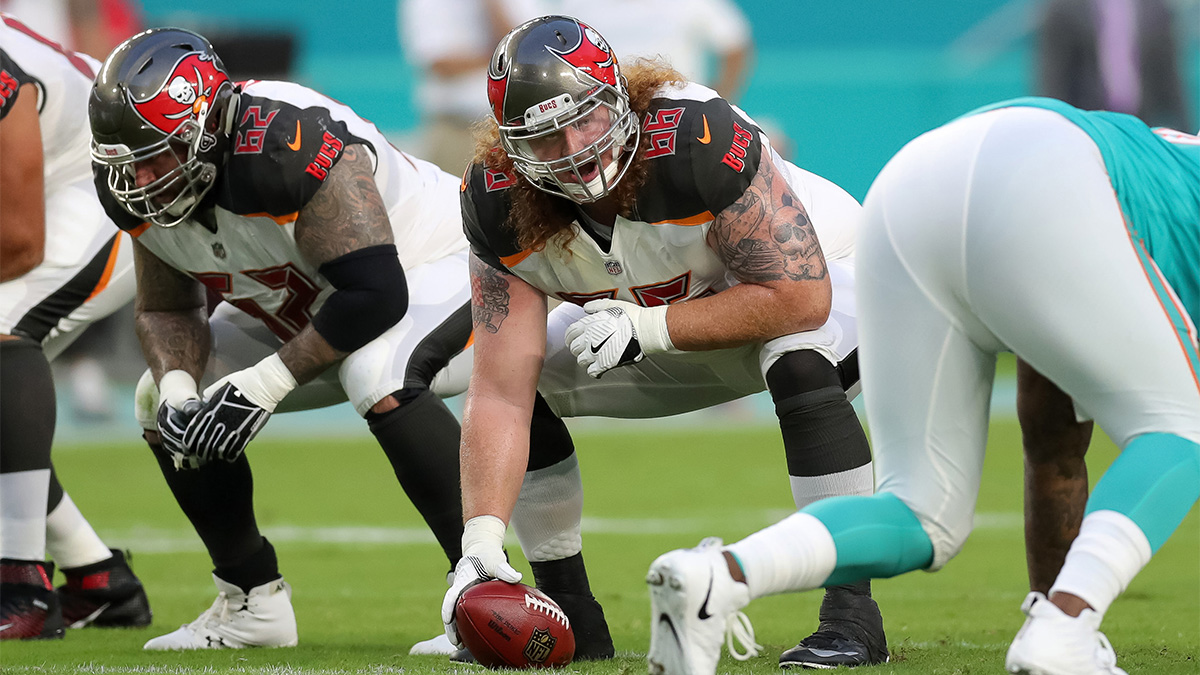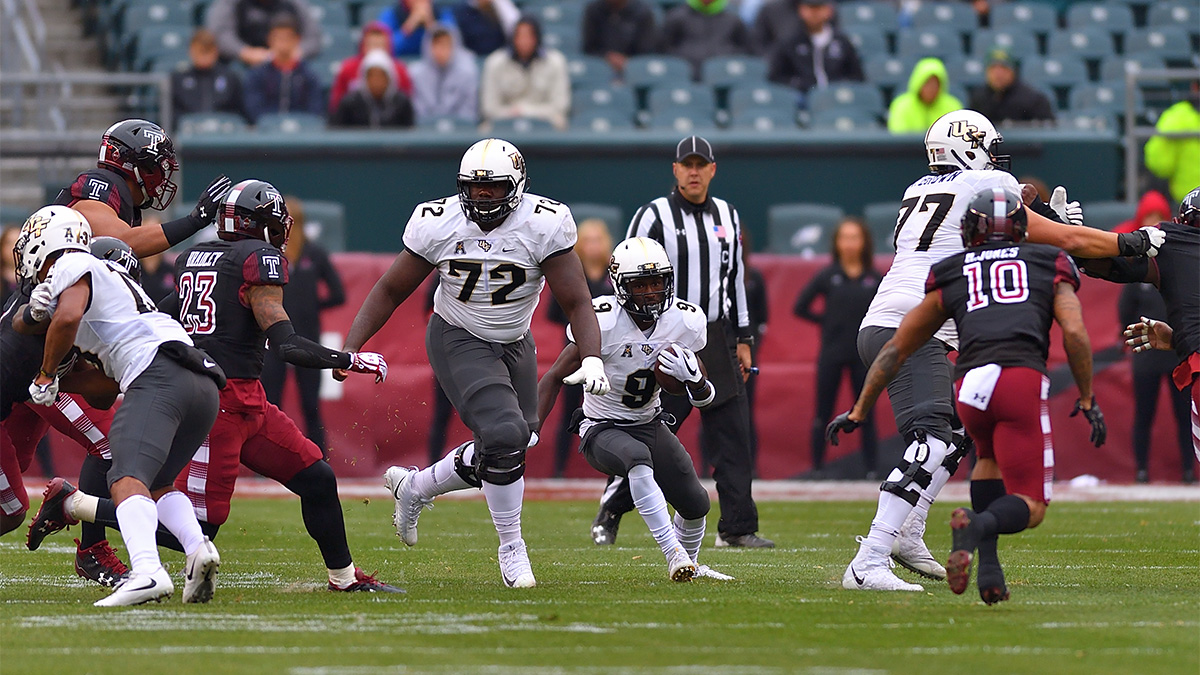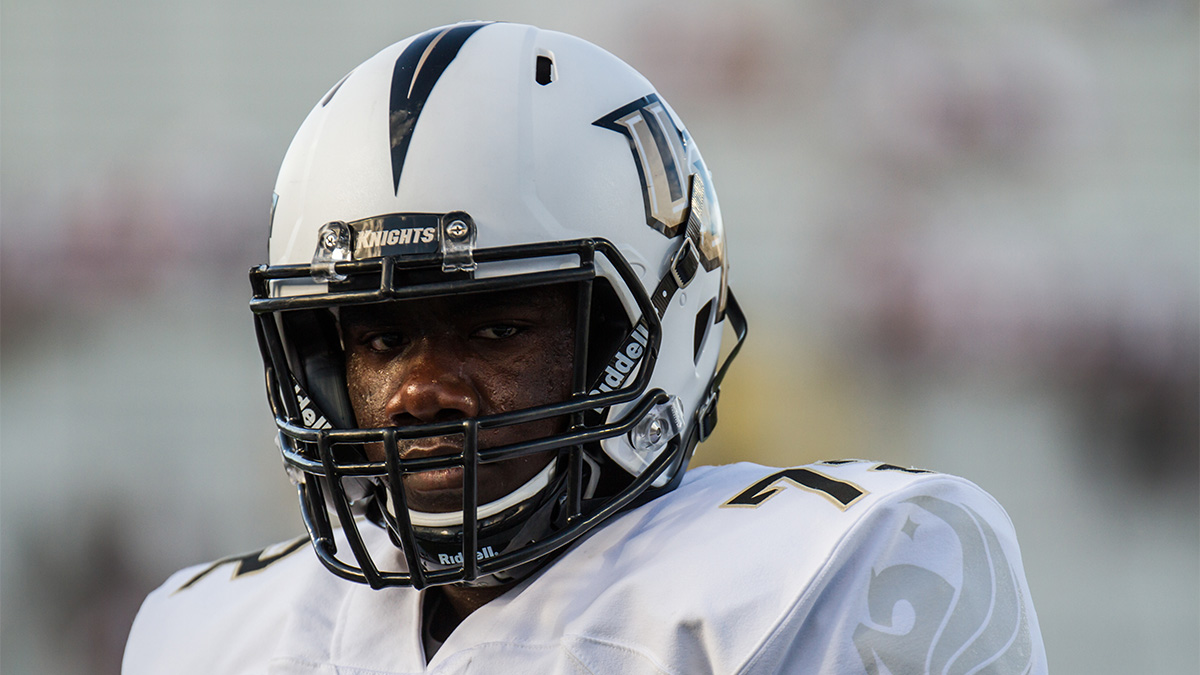Apnea is nothing to sleep on for football linemen - it can be deadly

University of Central Florida offensive lineman Jordan Johnson likes to say he is undefeated since getting a good night’s sleep.
He experienced a major victory away from the field in the spring of 2017 by overcoming a sleep disorder that repeatedly dragged him down.
A refreshed Johnson then helped lead the Knights to 13-0 season: major college football’s only unbeaten program in 2017.
“I am undefeated ever since I got a CPAP,” he said of Continuous Positive Airway Pressure device. The machine uses a hose and mask, or nosepiece, to deliver constant and steady air pressure into the airways and has helped Johnson experience much-improved quality and length of sleep. “I am not sure if it is something that affected me my whole life, but I was always a loud snorer and never really had good sleep. I just thought it was normal. But after (being on the CPAP) I have noticed the difference.”
Johnson noticed that difference immediately. The fact he experienced positive results the first night he used a CPAP is the general expectation.
“That’s very consistent with what we find,” said Matthew Buman, associate professor at Arizona State University’s College of Health Solutions. “A CPAP is a highly effective treatment for obstructive sleep apnea. In most cases, individuals that are having disordered breathing at night, when you give them a CPAP, which essentially will help keep their airway open at night, they almost invariably report much greater energy the next day and a greater quality of life. They feel rested in the morning.”
[beauty_quote quote='“The thicker the neck the greater the risk. It’s really anatomical in that the bigger the neck the smaller the airway, or the greater the weight on the airway the greater the risk of the airway shutting when they are sleeping.” - Arizona State University College of Health Solutions associate professor Matthew Buman']
At 6 feet, 2 inches tall and 320 pounds, Johnson has something in common with many football players, especially bigger offensive and defensive linemen: thick necks. A neck’s circumference can play a major role when it comes to impacting the airway.
Hence, it is not unusual for football players to be affected by the sleep disorder. The most notable is Hall of Fame defensive end Reggie White, who passed away the day after Christmas 2004 due to obstructive sleep apnea. Actors James Gandolfini and John Candy and actress Carrie Fisher are among notable personalities who have passed away as a result of sleep apnea.
“The thicker the neck the greater the risk,” Buman said. “It’s really anatomical in that the bigger the neck the smaller the airway, or the greater the weight on the airway the greater the risk of the airway shutting when they are sleeping.”

Ryan Jensen is a center for the Tampa Bay Buccaneers. The 27-year-old experienced severe sleep apnea early in his NFL career when he was a member of the Baltimore Ravens. Like many people suffering from the disorder, Jensen did not realize he had a sleep-related issue. He sought treatment at his father’s urging.
“My parents were the ones who actually recognized it first,” said Jensen, who is 6-4 and 320 pounds. “They said there was a change in my attitude and my dad said I should get checked out because it could be something that is easily treated.”
The change in attitude Jensen’s parents noticed is one of many side effects displayed by someone suffering from sleep apnea.
“Your mood is worse; you’re more irritable and more likely to be depressed if you are not getting good sleep,” said Shawn Youngstedt, professor within the Arizona State’s College of Nursing and Health Innovation.
Tests revealed Jensen was suffering from sleep apnea. The night his sleep was monitored it was revealed that at one point he went 48 seconds without taking a breath.
“I was waking up about every two minutes throughout the night,” he recalled. “I was only getting about an hour-and-a-half or two hours of sleep at night, but I was in bed for eight to 10 hours.”
As startling as it seems to go as much as 48 seconds without taking in any air, it is not unusual for such a period of time to elapse between breaths.
[beauty_quote quote='“I was waking up about every two minutes throughout the night. I was only getting about an hour-and-a-half or two hours of sleep at night, but I was in bed for eight to 10 hours.” - Tampa Bay Buccaneers center Ryan Jensen']
“It's really shocking to look at tests for those polysomnographic studies because you can clearly see periods of time when breathing completely ceases,” said Buman, referring to results from a person’s sleep study.
Jensen, like Johnson, immediately experienced positive results.
“Once I got on (the CPAP), everything started to feel good pretty quick,” he said. “When I did not sleep with it, I felt awful when I woke up the next day.”
The chronic sleep-related issues Johnson and Jensen experienced might beg the question why individuals do not get treated sooner. According to Buman, the average person is not aware he or she is having difficulty enjoying a good night’s sleep.
Even with the likelihood of going through the day feeling drowsy and with the desire to take a nap, affected individuals feel as though they actually had a good night’s sleep when indeed it was consistently disrupted.
“With sleep apnea, what’s happening is there are frequent interruptions in sleep which keeps individuals from getting into deeper and restorative forms of sleep,” Buman said. “Many people say that they slept through the night, but they never got any deeper type of sleep that would result in feeling well rested the next day. People with sleep apnea that go untreated rarely get those types of nights.”
Johnson can relate to that. During his freshman year, he said he was consistently falling asleep in team meetings and trying to remain alert in class. He said his coaches were among those wondering why he was always tired.
He spoke to the team’s trainers about his lack of energy. In an attempt to peel away the layers and get to the heart of the issue, Johnson was prescribed medications, including melatonin.
“Eventually that started to make me groggy in the morning,” he said. “I was coming to practice half asleep and I just went through the motions. So, I had to make a change.”
Change was in the form of two sleep studies set up by UCF. One night, Johnson was hooked up to sensors monitoring his sleep. Test results, which he said included very low oxygen levels, led to a diagnosis of sleep apnea.
[beauty_quote quote='“Just because you snore doesn’t mean you have apnea, but you are more likely to have it if you snore, are waking up with a dry mouth and fatigue.” - Arizona State University College of Nursing and Health Innovation professor Shawn Youngstedt']
In addition to monitoring oxygen levels, testing for sleep apnea measures various physiological parameters such as brain activity and the various stages of sleep. Also, tests detect if eyes are open and measure noise levels in the case of snoring, which can be a telltale sign of sleep apnea.
“Almost everybody who has apnea snores,” said Youngstedt. “Just because you snore doesn’t mean you have apnea, but you are more likely to have it if you snore, are waking up with a dry mouth and fatigue.”
The second night Johnson was tested he had a CPAP. The effect it had on him was pronounced.
“My sleep improved exponentially,” he said. “A couple of days (after testing), they gave me a CPAP and I use it every night.”
It can be difficult to adjust to wearing a CPAP, which fits over the ears or back of the head, or just covers the nose, mouth or both. According to Youngstedt, it can be cumbersome and even a little claustrophobic, but like most products improvements have been made over time.
“They are a lot more comfortable than they used to be,” he said. “They have become a lot more compact over the years, too, and it’s not nearly the issue it used to be.”
Jensen quickly adjusted to his CPAP.
“The first couple of nights were awkward,” he said. “But after starting with (a CPAP) I was getting a full night’s sleep and actually sleeping. After I was getting some real sleep, I noticed how much it helped.”
Johnson said his brothers laugh at him because he is sleeping with a mask, but he does not mind being the object of a little humor given how his life has changed for the better.
“I feel better and that’s all that matters,” he said. “It has helped out in academics, and I would say every area of my life. I think I am not only in the best shape of my life, but I feel the best I have ever felt. I can definitely attribute that to my CPAP.”

Wally Williams was diagnosed with sleep apnea 15 years ago, a year after the end of his 10-season career as an offensive lineman with the Cleveland Browns, Baltimore Ravens and New Orleans Saints.
His daughter, who was very young at the time, was showing signs of a sleep disorder. Only after getting her checked out did Williams realize he might want to undergo testing himself. During his playing days (1993-2002), there was not the level of awareness with respect to sleep apnea that there is today.
“I played with and did not address (my sleep disorders) until I took my daughter to address her sleep disorder,” said Williams, who was listed at 6-2 and 305 pounds in his final season. “She was maybe 5 or 6 years old and was sleepwalking, and we were wondering what’s going on. They put her through a sleep test and while the doctor was talking about her, I was thinking that I may want to go through (the testing) myself.”
During his playing career Williams, who said he was a snorer, often woke up feeling sluggish. He took that feeling to the practice field and other areas of his life. The sluggishness persisted after retiring from the game.
[beauty_quote quote='“Losing weight, staying somewhat conditioned and eating well are all things that helped with my sleep, that helped with my snoring. It was a combination of things that worked for me.” - former lineman Wally Williams']
The use of a mouth guard when sleeping helped Williams with his breathing and provided a much more restful night’s sleep. That was not the only thing that helped him, however. Looking out for his well being through diet and the like proved vital as well.
“Losing weight, staying somewhat conditioned and eating well are all things that helped with my sleep, that helped with my snoring,” he said. “It was a combination of things that worked for me.”
Those are among things Williams preaches as national spokesperson for DreamSleep, which is a national network of physicians and dentists working to combat sleep apnea. Dentists work with patients on custom oral appliances such as mouth guards.
Williams, who joined the company three years ago, educates current and retired players about the dangers of sleep apnea and what can be done to treat the disorder. He said it is something that too often gets overlooked especially when compared to ailments that are more commonly associated with football.
“There are so many things that players worry about in their post-career situations,” he said. “You talk about torn ACLs, arthritis and all these injuries that guys have. Now you address this other silent killer that a lot of guys don’t want to deal with. We go out of our way to present it, how to address it and understand the ramifications if you don’t address it.”
Tom Layberger has spent more than 25 years as a writer, editor and web producer for various media outlets. Tom, who resides in Tampa, is a graduate of the University of South Florida. Follow him on Twitter @TomLay810
Related Articles
A weighty issue: NFL linemen must contend with post-football pounds

